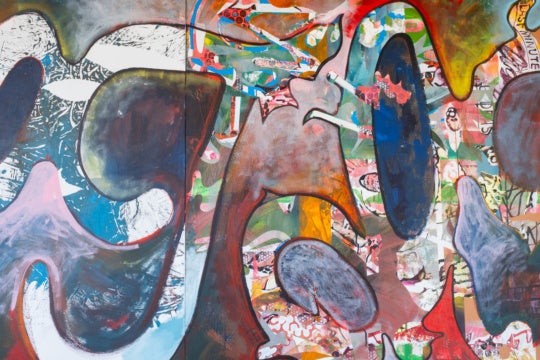
The Bushwick section of Brooklyn saw the opening of a new gallery, Life on Mars, this past October at 56 Bogart Street, a building that hosts a dozen galleries in an area that went from near zero to plus 40 in what seemed a blink of an eye. The director and curator is Michael David (b. 1954), best known as an abstract painter whose signature medium is encaustic (he has also been a photographer of note and was a punk rock musician), who shuttles between New York and Atlanta in his own tale of two cities.
David, a longtime New Yorker, had his first solo show with Sidney Janis in 1981, followed by an over two-decade association with the now defunct Knoedler Gallery. He headed south in 2001, first as an artist-in-residence at the Serenbe Institute for Art, Culture and the Environment in Palmetto, Georgia, then to Atlanta, teaching for a time at the Savannah College of Art and Design. He founded the Fine Arts Workshop (FAWS) in Atlanta in 2002, which he describes as a “painting hothouse” for emerging artists. His most recent show was at the Bill Lowe Gallery in Atlanta, which represents him. Not surprisingly, Life on Mars spotlights painting.

The venture evolved in part from his relationship with FAWS and the sense of community that it generated. He confessed that he didn’t know much about the region’s visual arts in the beginning, although he certainly knew about its extraordinary music and literature. But then he met Thornton Dial and other artists of similar material and emotional immediacy and intensity, one artist often introducing him to another. “Bushwick has the same sense of community; it’s a fantastic place to establish a platform,” he said. He had no idea how lively Bushwick had become and how much interest there was in painting. It reminded him of SoHo in its freewheeling heyday, even to the look of the gallery—clean but not Chelsea-perfect, a spacious, high-ceilinged 40-by-40-foot square with one wall of windows.
He saw the gallery as a way to link works from the late ’70s and ’80s with contemporary practices, pairing, as he does, a Susan Rothenberg painting from 1977 with young painters like Ben LaRocco. He wants to show what these works have in common and where they diverge. Most of all, he wants to capitalize on the energy and excitement he feels around him, to foster ongoing, cross-generational dialogues about painting past, present and future. Toward that end, David has presented exhibitions such as “Outside In” (January 17-March 2) in which self-taught artists, such as Dial from the South, were paired with formally trained artists Chris Martin, Katherine Bradford, and Joan Snyder from New York. Gee’s Bend quilters Loretta Bennett and Mary Lee Bendolph will also be showing at the gallery.

David likes the flow back and forth between Atlanta and New York, but as a natural exchange, not a programmatic one. All of the offerings had been themed group shows until a solo exhibition [April 11- May 11] of work by Arnold Mesches, a 91-year old painter now based in Florida known for socially critical paintings characterized by the impassioned, idiosyncratic, palpable brushwork that is already a gallery hallmark.
And why Life on Mars? “Because,” David said, “it’s a David Bowie song and it’s aspirational.”




